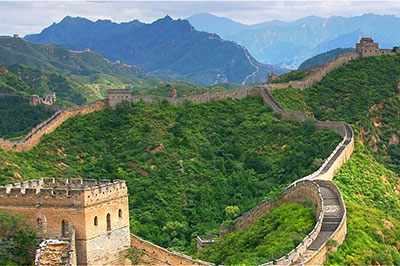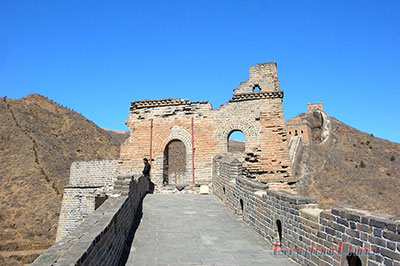Who Built the Great Wall of China?
Who Made the Great Wall of China?
Who First Built the Great Wall of China and Why

Among them, Qin, Zhao and Yan were adjacent to the powerful nomadic Xiongnu in the north, so while building the Great Wall for mutual defense of the vassals, they also built the "Great Wall against Hu" in the north. Almost all subsequent monarchs reinforced and added to it. At this time, the Great Wall was characterized by different directions to the east, south, west and north, and was shorter in length, ranging from a few hundred kilometers to one or two kilometers. In order to distinguish it from the 10,000-mile Great Wall built by Qin Shi Huang later, historians call it the "Great Wall of the First Qin".
The earliest sections of the wall were built in Zhou Dynasty, while the most well-known sections of the wall were built during the Ming Dynasty in the 14th to 17th centuries.
>> Keep reading: Why Was the Great Wall of China Built?
Who Ordered the Great Wall of China to be Built
The Great Wall of China was built by more than 20 Chinese dynasties over a period of approximately 2,000 years. It was the emperors and kings who ordered to build the Great Wall, and the conscripted laborers, soldiers, and convicts who actually built it. They were forced to work on the wall for years at a time.
Famous Emperors Who Built the Great Wall of China
Qin Shi Huang of Qin Dynasty (259-210 BC)
Although Qin Shi Huang was not the first to build the Great Wall, he was the first emperor to link the Great Wall together and create the Great Wall of China. In 217 B.C., after Qin Shi Huang united the six kingdoms, he sent Meng Tien to lead an army of 300,000 men to chase the Xiongnu in the north, and then began to build the Great Wall.
On the one hand, he repaired the northern Great Wall of the vassal states and connected them into one. On the other hand, he destroyed the Great Walls between the Central Plains, so that the local forces could no longer rely on them. It took nine years and countless manpower to complete this massive project.
>> Related reading: Qin Shi Huang's Terracotta Army
Emperor Wu of the Han Dynasty (156 - 87 BC)
At the beginning of the Han Dynasty, the Xiong Nu (Huns) from the north was unprecedentedly strong and invaded southward. The Han rulers were unable to fight against them for the time being. On the one hand, they had to adopt the policy of making peace, and on the other hand, they started to repair the Great Wall of China. By the time of Emperor Wu of the Han Dynasty, the Han Dynasty had become so powerful that it began a large-scale war with the Xiongnu. Under such circumstances, large-scale construction of the Great Wall also began.
One of the major projects was the construction of the more than 1,000 kilometre-long Great Wall of the Hexi Corridor, which stretched from Lingju (present-day Yongdeng, Gansu), through Jiuquan and Yumenguan passes, and all the way west to Yanze (present-day Lop Nor, Xinjiang). In addition to the wall itself, many barriers, castles and beacon tower were built to form a perfect defence system.
>> Related reading: Top 6 Greatest Dynasties of China
Taizu of Ming Dynasty (Emperor Hongwu) (1368-1398)
After the Ming Dynasty overthrew the Yuan Dynasty, the Mongolian nobles fled back to the north of the desert, but they still posed a great threat to the Ming. Therefore, the Ming Dynasty attached great importance to the defence of the north. The construction and consolidation of the Great Wall did not stop for more than two hundred years.
Zhu Yuanzhang, the first Ming emperor, sent General Xu Da to build the Great Wall at Juyongguan in 1368, and at Shanhaiguan in 1381.

Most of the ancient Great Wall around Beijing were built during the Ming Dynasty.
>> Recommended Great Wall of China tours from Beijing:
Who Really Built the Great Wall of China: Soldiers and Farmers
According to historical records, during the construction of the Great Wall, Qin Shi Huang used hundreds of thousands of labourers to participate in the construction. Not only engineers, craftsmen and skilled workers, but also a large number of farmers and soldiers are included. After General Mengtian led an army of 300,000 men to attack the Xiong Nu in the north, the army was converted into a wall-building regiment on the spot. In the Qin Dynasty, one out of every three members of a family was required to bring his own dry food to serve in the corps to build the Great Wall.
In the Ming Dynasty, General Qi Jiguang deployed his troops to repair the Great Wall of Jizhen, pioneering the hollow enemy tower. In present-day Hebei, peasants worked shifts for four months each year to build the wall.
Prisoners and prisoners of war from various dynasties also participated in building the Wall. During the Han Dynasty, grave robbers and deserters worked on the wall during the day and pounded rice at night. In the Ming Dynasty, after the Tumu Fortress Mutiny in 1449, prisoners of war were forced to participate in the construction of the Juyongguan Great Wall.
In addition, women in some dynasties undertook auxiliary work in the construction of the Great Wall, such as transporting earth and ramming foundations.
>> Recommended China tours with the Great Wall:
How did They Build the Great Wall of China?
Building the Great Wall of China was a colossal endeavor that demanded extensive resources and manpower. The wall was built using a variety of materials, including brick, stone, and earth. The builders used a variety of construction techniques, including rammed earth, bricks, and tamped earth. The wall was built in sections, with each section being constructed independently and then joined to the adjacent sections. >> Read more about What is the Great Wall of China Made ofHow Many People Died Building the Great Wall of China? Are Bodies Buried in the Wall?
The construction of the Great Wall of China was a dangerous and grueling task, and many workers lost their lives during its construction. It is estimated that as many as one million people died during the construction of the wall. Workers faced a variety of dangers, including falls from heights, injuries from falling rocks, and exposure to extreme weather conditions.Despite the massive death toll, there is no evidence to suggest that bodies were buried in the Great Wall of China. The wall was built using a variety of materials, including brick, stone, and earth, and it is unlikely that bodies would have been buried in the wall. However, there are many legends and myths surrounding the Great Wall of China, and some of these legends suggest that bodies were buried in the wall. This makes the Great Wall of China a source of fascination and wonder for people all over the world.